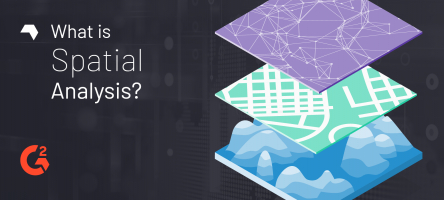Top 10 Best Online Spatial Data Analysis Courses
Spatial Analysis is regarded as a critical component of the current IT industry's infrastructure. The field of spatial analysis is growing. It's only a matter ... read more...of looking at where things happen to figure out why they happen there. These Best Online Spatial Data Analysis Courses were created by world-class instructors to assist novices establish solid foundations in spatial data analysis based on these industry trends.
-
On top of the Best Online Spatial Data Analysis Courses is [Intermediate] Spatial Data Analysis with R, QGIS & More. This course is meant to help users who are already familiar with R and QGIS for basic spatial data/GIS analysis do more sophisticated GIS activities (such as automated workflows and geo-referencing) with a range of data. You will be introduced to another sophisticated free GIS program in addition to becoming adept in R and QGIS for spatial data processing.
This course provides a hands-on approach to spatial data analysis and mapping, with each lesson teaching you a practical application/processing technique that you can use right away. The course's overarching goal is to guarantee that you can use spatial data analysis now and build solid GIS analytical abilities. You'll be able to begin studying spatial data for your own projects shortly after that.
Other training materials do not compare to this course. Each lecture aims to improve your GIS abilities in a verifiable and concrete way, as well as present you with GIS solutions that you can use right away. All of the data used in the course, as well as the R code files, will be available to you. Let's get started on the course right now and take advantage of this exclusive incentive!
Requirements:
- Basic knowledge of manipulating data using QGIS & R
- Basic understanding of different spatial data types & projections
- Mac and Linux users will have to adapt the instructions to their operating systems
- Have the latest versions of GRASS GIS and Google Earth installed on their computers
Who this course is for:
- People who have a basic understanding of spatial data analysis and want to learn more
- Students interested in building up on skills acquired through my previous course Core Spatial Data
- Analysis: Introductory GIS with R and QGIS
- Academics
- Conservation managers
- GIS Technicians
Course Rating: 4.7/5
Enroll here: https://www.udemy.com/course/intermediate-spatial-data-analysis-with-r-qgis-more/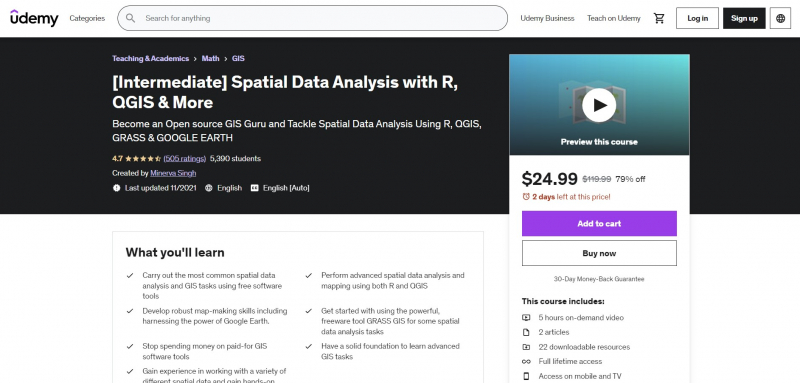
https://www.udemy.com/ 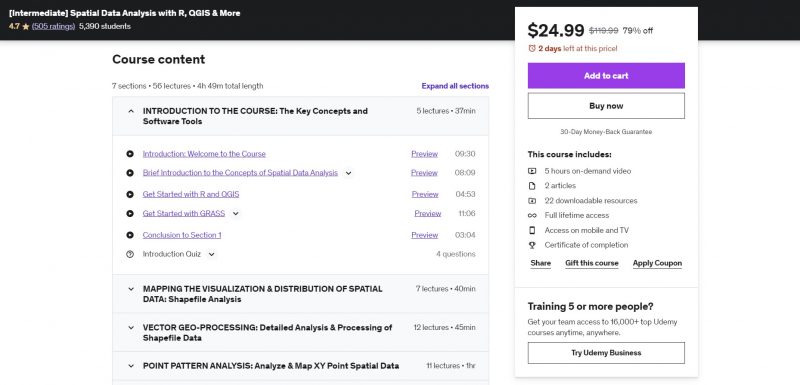
https://www.udemy.com/ -
One of the Best Online Spatial Data Analysis Courses is Advanced Remote Sensing Analysis in Open Cloud Tools & QGIS. This course will teach participants how to utilize QGIS and online cloud computing platforms (such as EO browser and others) to execute advanced geospatial analysis centered on change detection approaches (data differencing, post-classification comparison, and time series analysis) with Big Data. The training will also introduce you to GIS software tools and cloud-based apps for change detection approaches. The teacher will also show you how to use the EO-browser and AppEARS cloud computing tools to learn about user-friendly cloud computing.
You will feel competent and have a thorough understanding of advanced geospatial analysis in QGIS and on the cloud at the conclusion of the course. You'll learn how to use open source GIS software and cloud computing technologies to create realistic advanced applications. This course will also equip you to use open source and free software tools for geospatial analysis. The practical activities are a crucial component of the training. To produce the necessary datasets, algorithms, and instructions for geospatial analysis.
Requirements:
- The students should complete course on fundamentals of Remote Sensing
Who this course is for:
- Any professional that works with geographical data analysis and GIS maps
Course Rating: 4.5/5
Enroll here: https://www.udemy.com/course/advance-remote-sensing-analysis-in-open-gis-tools-qgis-etc/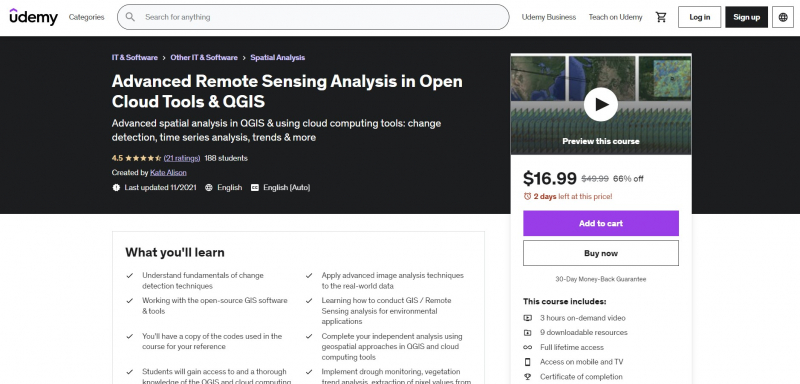
https://www.udemy.com/ 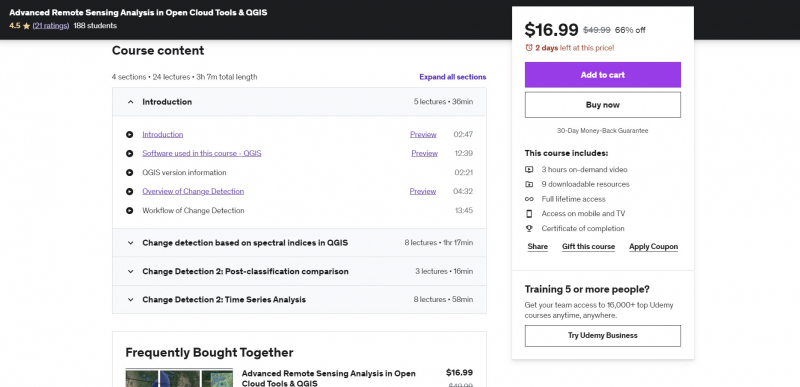
https://www.udemy.com/ -
This course is designed to give GIS experts who are interested in extending their skill set to multi-user enterprise level spatial databases an introduction to spatial databases in general and PostGIS in particular. The most recent versions of PostgreSQL (10.1), PostGIS (2.4), and QGIS are used in this course as of 2/18. (3.0). It is the most recent and comprehensive course on spatial databases that is currently offered.
You will discover what a spatial database is throughout the course and why you would wish to utilize one. Additionally, you will be aware of what SQL is, why it is useful, and how it relates to geographical notions. Alternately, you may understand how to load your spatial data into PostGIS and access it from a number of clients, including QGIS, as well as how to install PostGIS locally for development reasons and how to access a production version through a network or the internet. The following course covers the fundamentals of SQL for both spatial and non-spatial queries, as well as how to leverage PostGIS's built-in tools to validate data and manage user access.
Requirements:
- Familiar with GIS concepts and be willing to learn QGIS
Who this course is for:
- GIS professionals
Course Rating: 4.5/5
Enroll here: https://www.udemy.com/course/introduction-to-spatial-databases-with-postgis-and-qgis/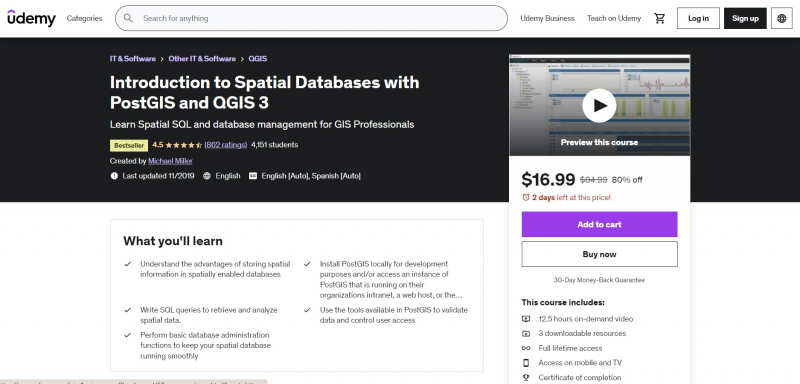
https://www.udemy.com/ 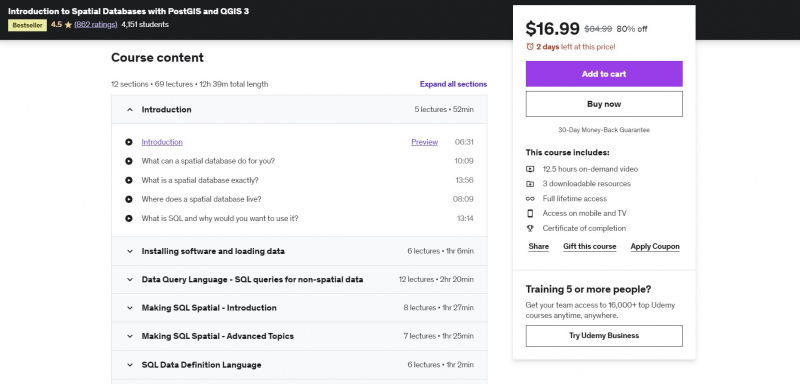
https://www.udemy.com/ -
This course intends to teach you how to use QGIS effectively and do typical GIS tasks using actual data. With the help of this course, you'll get familiar with everything needed to go from a beginner's level to doing some of the most crucial GIS analyses on actual geographical data. Some key GIS principles will be covered, along with examples of how QGIS may be used to apply them to actual data.
This involves performing crucial GIS operations including generating topographic products and spatial cluster mapping, as well as working with both raster and shapefile data. This course focuses on teaching you how to use the various spatial data analysis approaches on actual data, including dealing with the robust System for Automated Geoscientific Analyses (SAGA) processing toolkit and the Google Earth Engine (GEE) plugin.
You will learn a useful GIS technique to use to your own data from each session. Feel free to request a refund within 30 days of your purchase if this course ever leaves you disappointed. You would receive the money right away.
Requirements:
- An interest in working with spatial data
- Prior exposure to geographic information system (GIS) concepts
Who this course is for:
- Anybody who works/will work with spatial data and Geographic Information System (GIS)
- Academics who work with GIS
- Researchers working with GIS and spatial data
Course Rating: 4.5/5
Enroll here: https://www.udemy.com/course/practical-qgis-for-spatial-data-analysis-beginner-to-expert/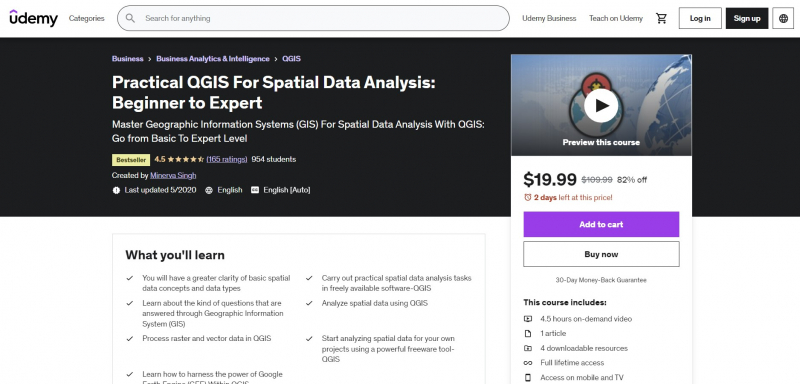
https://www.udemy.com/ 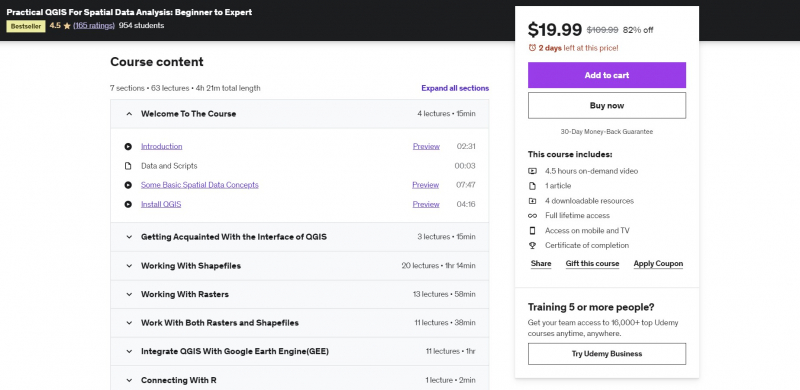
https://www.udemy.com/ -
The fundamentals of Python are covered in this course. suitable for GIS professionals without any programming or Python experience. Participants in the course will learn fundamental programming principles, geographic analysis libraries, geospatial APIs, and methods for creating pipelines for processing spatial data.
The majority of data that exists in the actual world is by its very nature geographical. The majority of datasets feature a geographic component that you may use to maximize what they have to offer, from the population reported in the national census to every store in your area. You will learn how to incorporate geographical data into your Python Data Science process in this course.
You'll learn how to use the spatial dimension of real-world data to interact with, modify, and enhance it. You will gain knowledge on how to read tabular spatial data in the most popular file types, such as GeoJSON, shapefile, and geopackage, and display it on maps. Then, you will mix several sources by using their geographic position as a link that connects them.
Requirements:
- Basic programming knowledge
- Basic understanding about the geospatial data
Who this course is for:
- Students
- Python users
- GIS users
- Anyone who is interested to work on spatial data
Course Rating: 4.4/5
Enroll here: https://www.udemy.com/course/geospatial-data-analysis-with-python/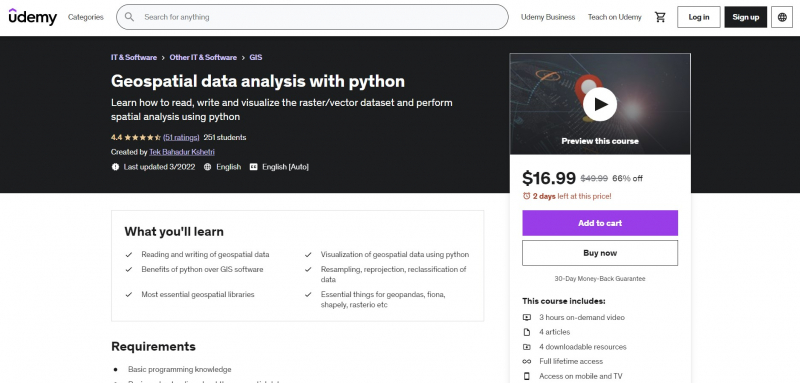
https://www.udemy.com/ 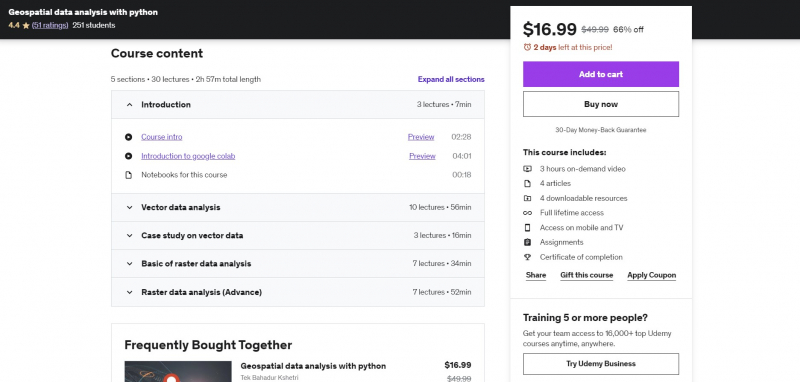
https://www.udemy.com/ -
At ArcGIS Pro 2.5, this course is being made available. It is intended for both ArcGIS Pro newcomers and those who just wish to learn more about using ArcGIS Pro for spatial data exploration. The focus of this specific course may touch on, but not go into depth with, broad themes including editing spatial data, creating maps and map series utilizing layouts, and geoprocessing using tools, models, tasks, and the Python ArcPy module.
ArcPy has a comprehensive companion course (ArcPy for Python Developers using ArcGIS Pro) and map series has a brief companion course (Map Series made easy with ArcGIS Pro), while companion courses for the remaining topics are in the works. The most popular ArcGIS Pro capabilities for examining spatial data are thoroughly examined in this course. The presenter's expertise working with ArcGIS Pro for 5 years and Esri products for more than 30 years informed the examples picked to demonstrate how each feature is used.
Requirements:
- Have a license to use ArcGIS Pro
- Have a laptop or PC that meets ArcGIS Pro system requirements
Who this course is for:
- Beginners who may never have started ArcGIS Pro
- Existing ArcGIS Pro users who want to learn new and alternative ways to do things
Course Rating: 4.4/5
Enroll here: https://www.udemy.com/course/exploring-spatial-information-using-arcgis-pro/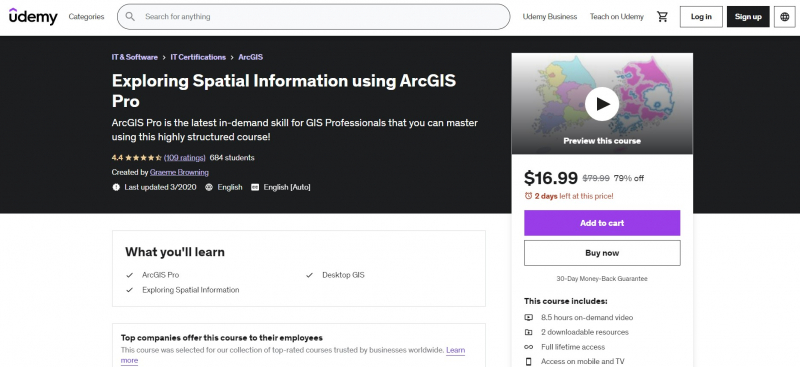
https://www.udemy.com/ 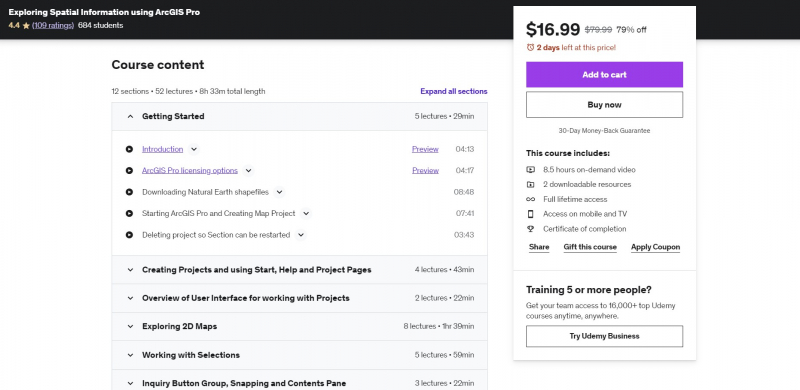
https://www.udemy.com/ -
ArcGIS Desktop For Spatial Analysis: Go From Basic To Pro is also one of the Best Online Spatial Data Analysis Courses. The teacher has created a number of courses on Udemy over the past several months that will be very beneficial to you and, most importantly, are reasonably priced. You will learn how to use ArcGIS Desktop, one of THE MOST IMPORTANT GIS software tools available, to conduct the most frequent and significant geo-processing tasks in this course, which includes over 50+ hands-on and practical lectures.
This course will also cover basic theoretical ideas in spatial data analysis before concentrating on using some of the most popular GIS techniques (all the way showing you how to execute these tasks in ArcGIS Desktop). The knowledge you get from this course will be very beneficial for you to apply to future Spatial Data projects you will be working on (in a variety of disciplines from ecology to engineering). This course offers practical instruction using actual data. The theory and implementation of geographical data analysis are both covered in this step-by-step course.
Requirements:
- Prior knowledge of basic spatial data related concepts
- Access to ArcGIS Desktop version 10 or above
- License for the Spatial Analyst extension of ArcGIS version 10
Who this course is for:
- Academics and Researchers
- Conservation managers, field ecologists and social scientists
- People looking to get started in the field of GIS Analysis
- Students of Geography, Environmental Sciences, Geology, Hydrology, Engineering, Earth Sciences and Ecology
- People looking to use ArcGIS Desktop in academic or professional settings
Course Rating: 4.4/5
Enroll here: https://www.udemy.com/course/arcgis-desktop-for-spatial-analysis-go-from-basic-to-pro/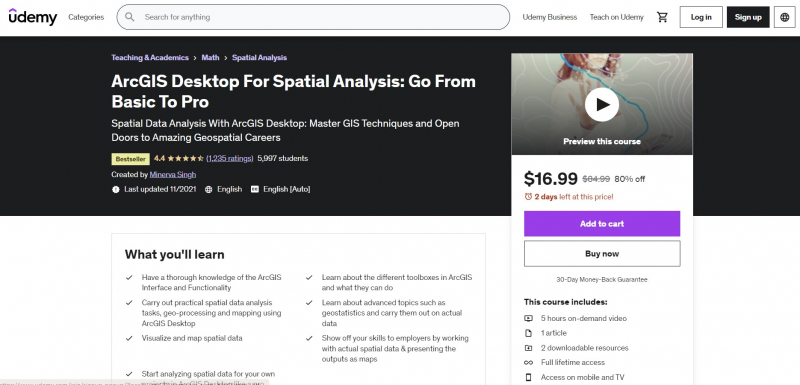
https://www.udemy.com/ 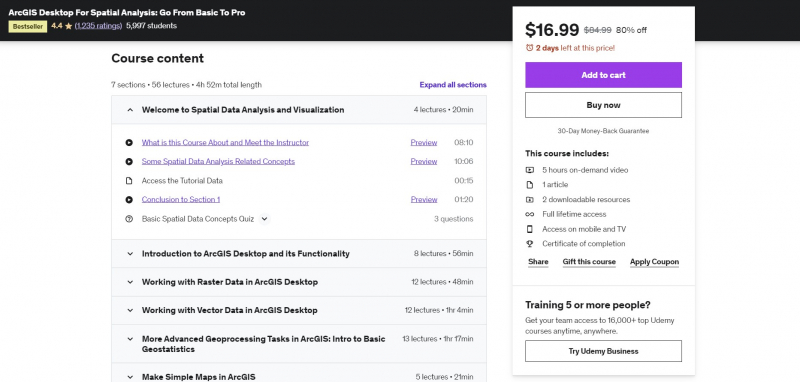
https://www.udemy.com/ -
Are you seeking for a course that walks you through every topic, teaches you what you need to know, and gets you started on a real-world project because you find GIS and spatial data books and manuals to be too nebulous, pricey, and impractical?
The Tam Dao National Park in Vietnam's genuine geographical data will be utilized in this course to provide students with a practical, hands-on introduction to dealing with real-world spatial data and an understanding of the kinds of problems. The main goal of the course is to prepare you to use spatial data analysis in the real world. Regardless of your skill level, start analyzing spatial data for your own projects so you can IMPRESS future employers with a working example of your spatial data analysis skills.
You will only spend a brief amount of time working with some of the theoretical principles connected to spatial data analysis because this is a practical, hands-on course. However, the majority of the course will be devoted to using spatial data from Vietnam's Tam Dao National Park. You will pick up a new idea or skill from each video that you may use on your own projects.
Requirements:
- An interest in working with spatial data.
- Windows PC. Mac and Linux users will have to adapt the instructions to their operating systems.
Who this course is for:
- Academics
- Researchers
- Conservation managers
- Anybody who works/will work with spatial data
Course Rating: 4.4/5
Enroll here: https://www.udemy.com/course/core-spatial-data-analysis-with-r-and-qgis/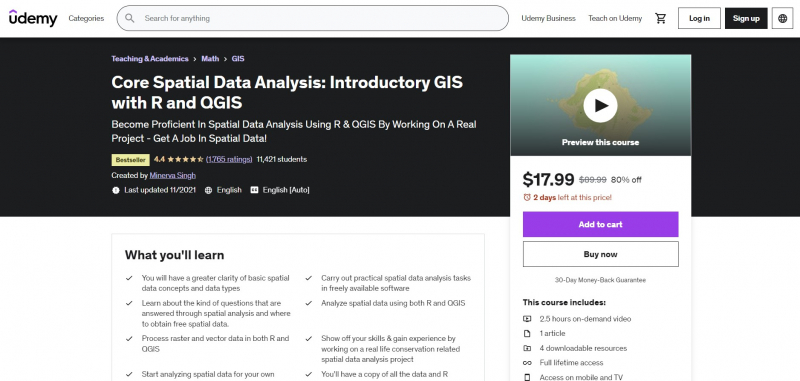
https://www.udemy.com/ 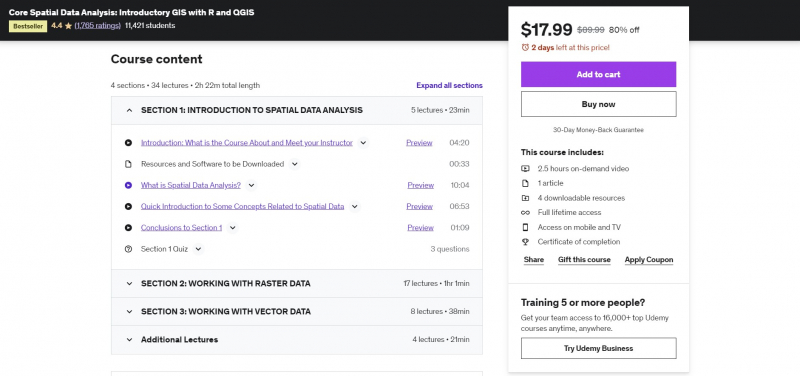
https://www.udemy.com/ -
Do you wish to use the Jupyter Notebook with Earth Engine Python API to access satellite sensors? Do you want to study cloud-based spatial data science? Do you wish to pursue a career in spatial data science? Let's sign up for my new course on spatial data analysis using the Python API for Google Earth Engine. It will provide you practical instruction using real-world applications, sample scripts, and example data.
You may install Anaconda and Jupyter Notebook after completing this course. The Earth Engine Python API will then provide you access to satellite data. The instructor in this Earth Engine Python API course on spatial data analysis will assist you in setting up and using Jupyter Notebook and the Earth Engine Python API. By the end of the course, you will have access to all sample data and scripts, enabling you to download, view, and extract information from large amounts of data.
Requirements:
- None
Who this course is for:
- Professionals who want to harness the power Google Earth Engine Python API and Jupyter Notebook
- People who desire to comprehend different Python and Jupyter Notebook-based satellite image processing approaches.
- Anyone who is interested in learning how to access and extract data from Earth observation.
- Anyone who wishes to submit an application for a job as a spatial data scientist.
Course Rating: 4.3/5
Enroll here: https://www.udemy.com/course/spatial-data-analysis-with-earth-engine-python-api/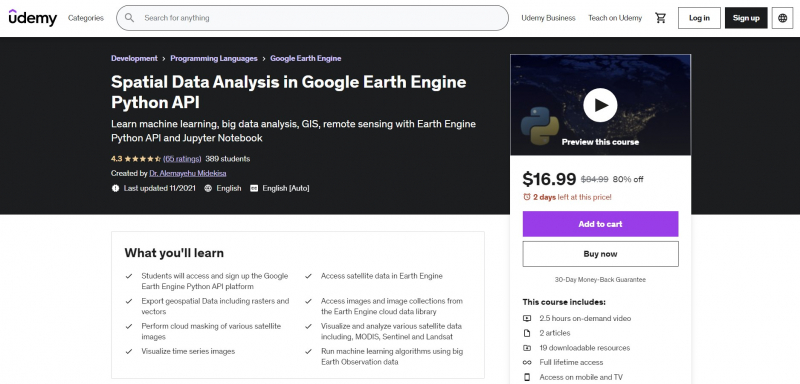
https://www.udemy.com/ 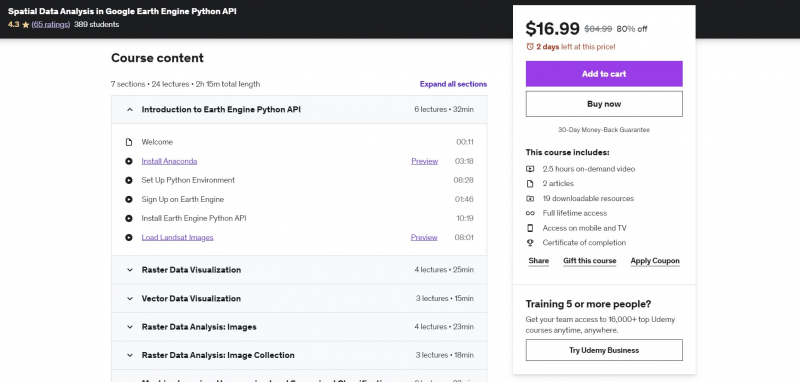
https://www.udemy.com/ -
Are you seeking for a course that will walk you through everything, teach you all the principles, and get you started on a real-world Remote Sensing analysis assignment because you find Remote Sensing books and manuals to be too theoretical? You have now discovered the QGIS course's Fundamentals of applied satellite remote sensing.
Starting with the fundamental concepts of remote sensing, this course gives you all the theoretical knowledge and practical skills you need to implement PRACTICAL, remote sensing analysis. It also gives you the tools you need to implement your own independent remote sensing analysis project using the fantastic QGIS open-source software.
Additionally, the instructor will show you how to include Remote Sensing analysis in the most recent version of the free program QGIS, enabling you to start using satellite photos for your work and Remote Sensing projects right now. The practical activities are a crucial component of the training. To use the QGIS program to make maps and do geospatial analysis, you will be provided with clear instructions, downloadable instructional materials, practical materials, scripts, and datasets.
Requirements:
- A working computer
- A Windows PC running the QGIS version will be used to demonstrate the course. Users of Mac and Linux systems will need to modify the instructions for their platforms
Who this course is for:
- Geographers, Programmers, geologists, biologists, social scientists, or every other expert who deals with GIS maps in their field
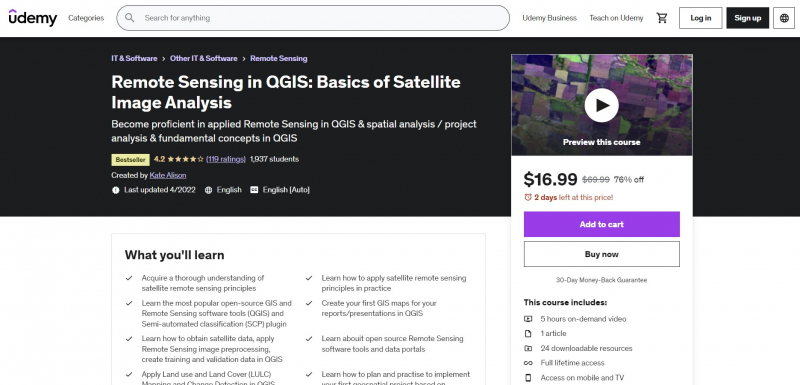
https://www.udemy.com/ 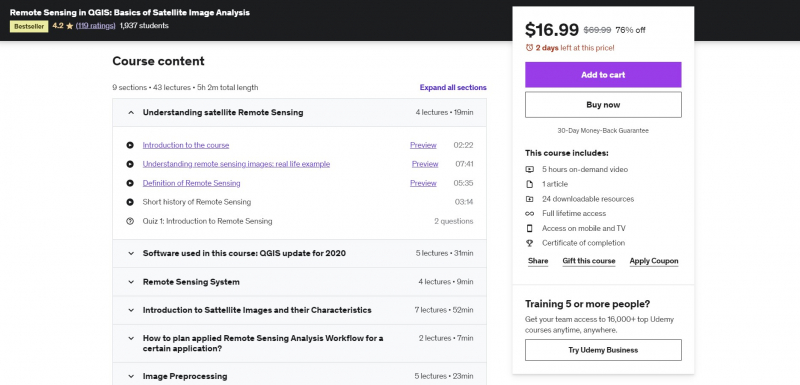
https://www.udemy.com/














